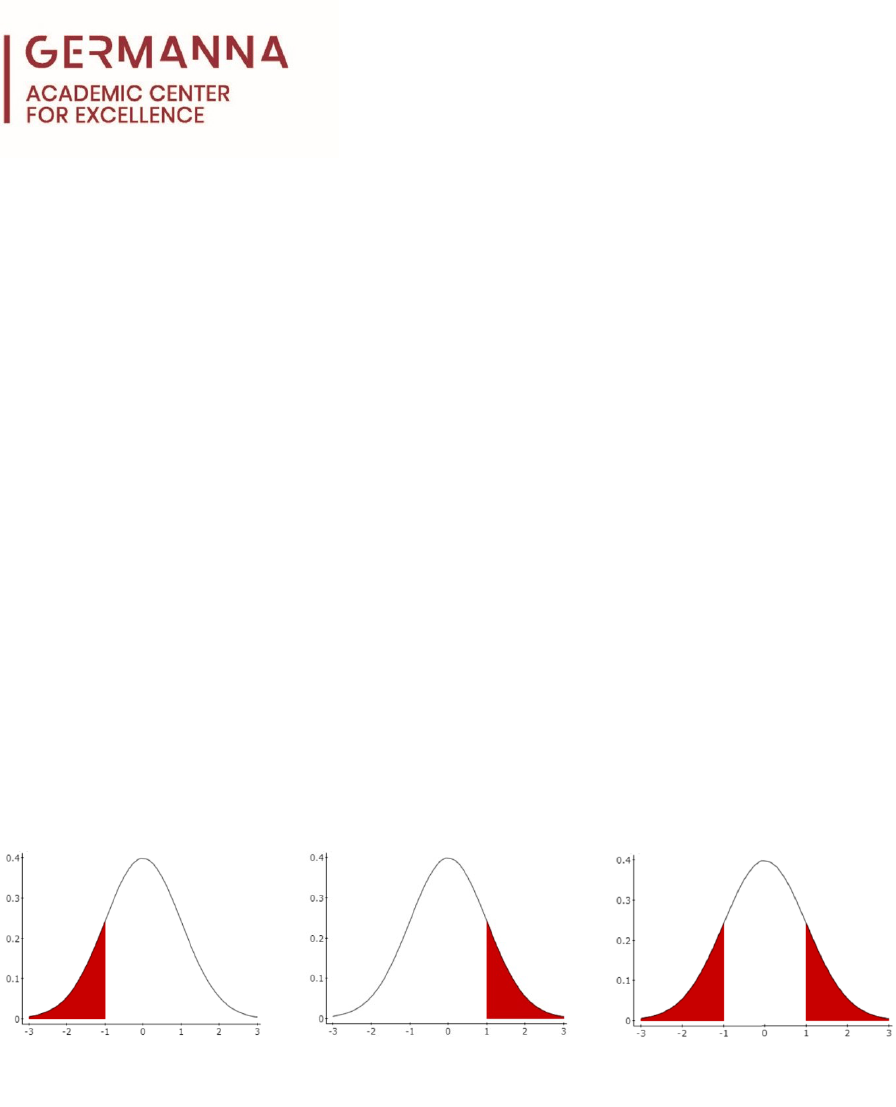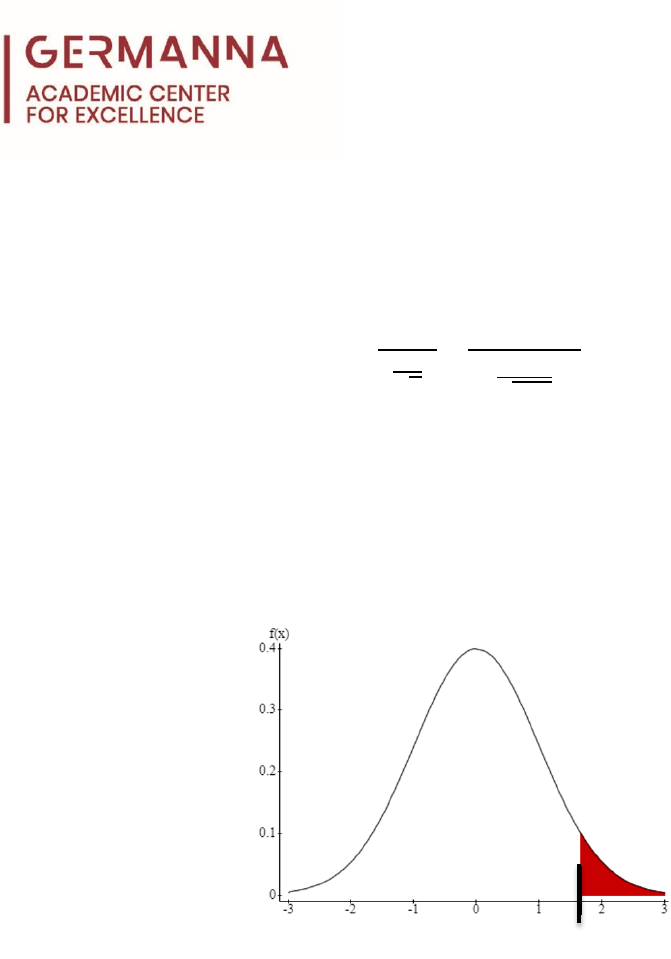
Provided by Statistics: Hypothesis Testing
The Academic Center for Excellence 1 Updated April 2020
Statistics: Hypothesis Testing
A hypothesis is a claim made about a population. A hypothesis test uses sample data to test
the validity of the claim. This handout will define the basic elements of hypothesis testing and
provide the steps to perform hypothesis tests using the P-value method and the critical value
method. Many statistics courses use statistical calculation tools; however, this handout is
designed for manually computed formulas.
Basics of Hypothesis Testing
All hypothesis tests consist of a null hypothesis (H
0
) and an alternative hypothesis, which can
be noted as H
A
, H
a
, or H
1
.
The null hypothesis must be written with an equality (=, , or ),
and the alternative hypothesis must be written with an inequality (<, >, or ). Based on the
inequality sign in the alternative hypothesis, there are three types of tests: right-tailed test
(>), left-tailed test (<), and two-tailed test (). Below are diagrams of the three possible tests
represented as distribution curves:
The shaded area of the graph represents the rejection region. The critical value is the z or t
score that separates the rejection region from the fail to reject region.
Test Statistic
A test statistic is used to decide whether to reject or fail to reject the null hypothesis. It
converts the sample statistic (proportion, p or mean, x) to a score (z or t) by comparing the
sample statistic to the null hypothesis. The test statistic that is used is dependent upon the
parameter (mean, µ or proportion, p) being tested and whether the population standard
Left-tailed
Right-tailed
Two-tailed

Provided by Statistics: Hypothesis Testing
The Academic Center for Excellence 2 Updated April 2020
deviation (σ) is known. Refer to the following table for formulas when deciding which test
statistic is required for a given problem. Always remember to check the requirements.
Sampling
Distribution
Requirements Formula StatCrunch
Normal
Distribution (z)
for mean
1. σ is known
2. Normal
distribution or
n > 30
z =
x - μ
σ
n
x = Sample mean
µ = Population mean
σ = Population standard
deviation
n = Sample size
1. Stat > Z stats > one
sample
2. Choose with data
or with summary
3. Perform:
Hypothesis test
4. Compute
t Distribution
for mean
1. σ is unknown
2. Normal
distribution or
n > 30
t =
x - μ
s
n
x = Sample mean
µ = Population mean
s = Sample standard
deviation
n = Sample size
1. Stat > T stats > one
sample
2. Choose with data
or with summary
3. Perform:
Hypothesis test
4. Compute
Normal
Distribution (z)
for proportion
1. np 5
2. n(1 p) 5*
*some sources use
q instead of (1 - p)
z =
p - p
p(1 - p)
n
p = Sample proportion
p = Population proportion
n = Sample size
1. Stat > Proportion
stats > one sample
2. Choose with data
or with summary
3. Perform:
Hypothesis test
4. Compute

Provided by Statistics: Hypothesis Testing
The Academic Center for Excellence 3 Updated April 2020
Significance Level (α)
The significance level is the probability value that is used to determine the cutoff for significant
evidence against the null hypothesis. Typical significance levels are .05 and .01. The level will
be given in the problem.
Hypothesis Testing Steps
Step 1: Identify the claim and express in symbolic form.
Step 2: Write the null and alternative hypothesis.
Step 3: Calculate the test statistic.
Step 4: Find the P-value or critical value.
Step 5: Decide to reject or not to reject.
Step 6: Make a statement regarding the validity of the claim in the hypothesis test.
Example 1:
A study in 2000 found that 85 out of 100 Virginia residents own a dog. A simple random
sample of 2500 people from Virginia was gathered, and the proportion of people who own a
dog was found to be 0.84. Perform a hypothesis test at the 0.05 significance level (α) to test
the claim that the proportion of dog owners in Virginia is now less than 85%.
Step 1: Identify the claim and express in symbolic form
When determining the claim, look for the sentence containing inequality keywords (ex.
less than, greater than, or not equal to). The claim is often in the last sentence of the
problem. Proportion problems will contain fractions, percentages, or the key words
“out of”. The claim for this problem is that the proportion of dog owners in Virginia is
less than 85%. In symbolic form, p < 0.85. The less than symbol means it is a left-tailed
test.
Step 2: Write the null and alternative hypothesis
If the claim contains an equality (=, , ), it will be the null hypothesis. If the claim
contains an inequality (<, >, ), it will be the alternative hypothesis. Because the claim
in this example is an inequality, it is the alternative hypothesis (H
A
). The null hypothesis

Provided by Statistics: Hypothesis Testing
The Academic Center for Excellence 4 Updated April 2020
(H
0
) will be the population proportion equal to the claimed proportion. The hypotheses
are written in the form:
H
0
:
p
= 0.85
H
A
:
p < 0.85
Step 3: Calculate the test statistic.
According to the table on page 2, the normal distribution is used for proportion
hypothesis tests. Before calculating the test statistic, check the requirements to show
that the data behaves like a normal distribution.
n × p =
(
2500
)(
0.85
)
= 2125
n ×
(
1 p
)
= 2500
(
1 0.85
)
= 375
Because both values are greater than or equal to 5, the requirements are met for a
normal distribution, and the test statistic can be calculated.
=
p p
p(1 p)
n
=
0.84 0.85
0.85(1 0.85)
2500
1.40
If the requirements are not met, a hypothesis test cannot be performed.
Step 4: Find the P-value or critical value.
a. P-value method: The P-value method compares the P-value associated with the
test statistic to the significance level. Find the P-value using the z-score table. For a
left-tailed test, locate the P-value corresponding to the z-score. For a right-tailed
test, the P-value found in the table should be subtracted from 1. For a two-tailed
test, multiply the P-value found in the table by 2. The P-value for this problem is
0.081.
b. Critical value method: The critical value method compares the test statistic to the
critical value. Use a t-distribution table or normal distribution table to determine
the critical value for the significance level given in the problem. In this case, the
normal distribution table is used to determine that the critical value at the 0.05
significance level is -1.645.

Provided by Statistics: Hypothesis Testing
The Academic Center for Excellence 5 Updated April 2020
Step 5: Decide to reject or not to reject.
a. P-value method: Refer to the table below to decide whether to reject or fail to
reject the null hypothesis.
Reject the null
Fail to reject the null
P-value ≤ α
P-value > α
Because the P-value 0.081 is greater than α, 0.05, we must fail to reject the null
hypothesis.
b. Critical value method: This is a left-tailed test, meaning any test statistic that falls
below the critical value, in the rejection region, will result in a rejection of the null
hypothesis. Because the test statistic, -1.40, is greater than the critical value,
-1.645, we fail to reject the null hypothesis.
Step 6: Make a statement regarding the validity of the claim in the hypothesis test.
Based on the previous steps, write a final statement about the claim. The statement
will consist of two separate sentences: the first states the decision regarding the null
hypothesis, and the second states whether there is sufficient evidence to support the
original claim of the problem. The table on the following page can be used to write
the statement.
-1.645

Provided by Statistics: Hypothesis Testing
The Academic Center for Excellence 6 Updated April 2020
Where is the claim?
Decision
Conclusion Statement
Null Hypothesis (H
0
)
Fail to reject H
0
There is insufficient evidence to
reject the claim that…
Reject H
0
There is sufficient evidence to
reject the claim that…
Alternative Hypothesis (H
A
)
Fail to reject H
0
There is insufficient evidence to
support the claim that…
Reject H
0
There is sufficient evidence to
support the claim that…
Below is an example of a statement for this problem.
There is not sufficient evidence to warrant the rejection of the null hypothesis.
There is insufficient evidence to support the claim that the proportion of dog
owners in Virginia is less than 85%.
Example 2: A group of statisticians in 2010 concluded that the mean amount of time people
in Virginia spend on their cell phones per day is 180 minutes. A group of statisticians claims
that the mean time has since increased. They surveyed 100 Virginia residents and found that
the mean amount of time people use their cell phones is 189 minutes per day. Assume the σ
is 50. Perform a hypothesis test at the 0.05 significance level to test the claim that the actual
mean time that Virginians spend on their cell phones per day is greater than 180 minutes.
Step 1: Identify the claim and express in symbolic form
The claim is that the actual mean time Virginians spend on their cell phones per day is
greater than 180 minutes, written symbolically as, > 180. The greater than symbol
means this is a right-tailed test.
Step 2: Write the null and alternative hypothesis.
The claim does not contain an equality; therefore, the claim is the alternative
hypothesis. The hypotheses are:
H
0
: = 180
H
A
: > 180

Provided by Statistics: Hypothesis Testing
The Academic Center for Excellence 7 Updated April 2020
Step 3: Calculate the test statistic.
Because the claim is about the mean, and the population standard deviation is known,
the normal distribution is used.
z =
x
n
=
189 180
50
100
= 1.80
Step 4: Find the P-value or critical value.
a. P-value method: Using a z-score table, the P-value is found to be 0.0359.
b. Critical value method: The critical value for a right-tailed test at a 0.05 significance
level is 1.645.
Step 5: Decide to reject or fail to reject.
a. P-value method: The P-value, 0.0359, is less than the significance level, 0.05, so we
reject the null hypothesis.
b. Critical value method: This is a right-tailed test, meaning any test statistic that falls
above the critical value will result in a rejection of the null hypothesis. Because the
test statistic, 1.80, is greater than the critical value, 1.645, we reject the null
hypothesis.
Step 6: Make a statement regarding the validity of the claim in the hypothesis test.
There is sufficient evidence to warrant the rejection of the null hypothesis. There is
sufficient evidence to support the claim that the mean time Virginians spend on their
phones is greater than 180 minutes per day.
1.645
